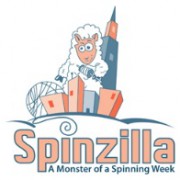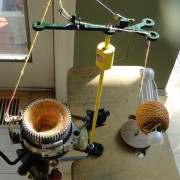Third Thursdays Guild Tip
Time to ramp up for tonight’s PLY Spinners Guild Third Thursday foundational spin-in! We’d like to take a moment to feature some tips from one of our wonderful PLY Guild spin-in leaders, Donita Westman.
The old saying is that “practice makes perfect”; over twenty years ago, my music education mentor challenged me to consider if that was true or if “practice makes permanent” was more accurate. (Spoiler: she was right. She’s always right!) Learning to spin requires practice and the way you spin is a result of that practice. Whether you’re new to the craft or a seasoned spinner looking to try a new technique, what and how you practice will determine the kind of spinner you become. Since we talk about the importance of practicing but often skip over how to practice, I wanted to share a few tips on how to approach practice that will help you become better practicing anything.
Set the mood
Practicing a new skill is challenging. If we come into a practice session stressed and anxious, we will be less successful and, over time, associate spinning with stress and anxiety. While we can’t solve the world’s problems before we sit down to spin, taking a few minutes to clear our minds and let those emotions flow through us and go on their way before we start our practice session will make it more enjoyable and successful. Make a mug of your favorite warm beverage, turn on some relaxing music, take as many deep breaths as you need, do some gentle stretches, or do all of the above! Engaging your senses allows you to focus on your spinning. Actively thinking about how you are spinning is necessary to learning that new technique!
Set a goal for your practice session
Focus on one aspect of your spinning for this time. Choose a goal that you know is achievable in the time you have and make your goal observable. Ask yourself “How will I know if what I’m doing is working or not?” For example, if I want to work on more consistent drafting distance for a yarn with consistent diameter, I can find reference points for how far my hands are moving, look at how opaque or transparent the fiber in my drafting triangle is, and look at a ply-back sample every so often to see if my yarn has fewer thick and thin spots.
If I’m not seeing progress toward my goal, I can consult a spinning resource (like PLY, a spinning book, a spinning teacher, or an experienced spinner who creates yarn like what I want to create) to find a strategy that moves me toward this goal, not reinforcing habits that aren’t working. If I find my yarn is becoming more consistent, great! I can continue using those strategies to make this practice permanent.
Set a timer
Any time you are building a new skill, you want to set a time limit for your practice session. I recommend 15-minute sessions, with an optional second 15-minute session after a short break. These breaks are good for your body, as you are using your muscles in ways they might not be used to moving or holding them tensely as you focus on your goal. Taking a break to get up, have a sip of water or tea, or look out the window for a minute gives your body a chance to let you know if you have resources to continue or if you’re feeling fatigued and need rest. These breaks are also good for your brain, so you can process what’s working for you and check in with your emotions to see if you’re feeling frustrated. If at the end of 30 minutes, you’re feeling good – that’s the time to step away! Putting your spinning down while you’re feeling positive will bring you back time and again, while quitting when you’re frustrated will discourage you from future practice because you associate spinning with frustration. If you are drawn back to your spinning later in the day, try another 15-minute session, but always remember to get out while the getting’s good!
Learning to practice takes less time than you think. Once you learn to practice, the skills will come more quickly and easily. The more you learn new things, the more you’ll want to learn more new things. Think of all the possibilities that will open up for your spinning once you master how to practice!










Leave a Reply
Want to join the discussion?Feel free to contribute!